Library of Congress's Blog, page 132
April 18, 2016
WWI Exhibit Opens Next Month
An exhibition showing how American artists galvanized public interest in World War I will open Saturday, May 7 at the Library of Congress.
“World War I: American Artists View the Great War” opens in the Graphic Arts Galleries featuring 25 fine prints, drawings, cartoons, posters and photographs drawn from the Library’s Prints and Photographs Division. An additional 70 photographs will be shown in a monitor slide show. The works on display reflect the focus of wartime art on patriotic and propaganda messages—by government-supported as well as independent and commercial artists. In the fall, an exhibition rotation will occur and 27 new items will be placed on display. A total of 40 artists will be represented.
Many of the artists featured in the exhibition worked for the federal government’s Division of Pictorial Publicity, a unit of the Committee on Public Information. Led by Charles Dana Gibson, a preeminent illustrator, the division focused on promoting recruitment, bond drives, home-front service, troop support and camp libraries. Many images advocated for American involvement in the war and others encouraged hatred of the German enemy. In less than two years, the division’s 300 artists produced more than 1,400 designs, including some 700 posters.
Heeding the call from Gibson to “Draw ‘til it hurts,” hundreds of leading American artists created works about the Great War (1914–1918). Although the United States participated as a direct combatant in World War I from 1917 to 1918, the riveting posters, cartoons, fine art prints and drawings on display chronicle this massive international conflict from its onset through its aftermath.
Among those who heeded the call were James Montgomery Flagg (best known for his portrayal of Uncle Sam), Wladyslaw Benda, George Bellows, Joseph Pennell and William Allen Rogers. In contrast, such artists as Maurice Becker, Kerr Eby and Samuel J. Woolf drew on their personal experiences to depict military scenes on the front lines as well as the traumatic treatment of conscientious objectors. Finally, cartoonists offered both scathing criticism and gentle humor, as shown in Bud Fisher’s comic strip “Mutt and Jeff.”
Photography also provided essential communication during the First World War. The selected images detail the service of soldiers, nurses, journalists and factory workers from the home front to the trenches. American Red Cross photographs by Lewis Hine and others employ artful documentation to capture the challenges of recovery and rebuilding in Europe after the devastation of war.
With the most comprehensive collection of multi-format World War I holdings in the nation, the Library is a unique resource for primary source materials, education plans, public programs and on-site visitor experiences about The Great War, including exhibits, symposia and book talks. The Library of Congress blog will highlight in a series of posts online content related to WWI through the year.
“World War I: American Artists View the Great War” will remain open for a year, closing on May 6, 2017.
The exhibition is made possible by the Swann Foundation for Caricature and Cartoon, and is the first in a series of events the Library is planning in connection with the centennial of the United States’ entry into World War I. An online version of the exhibition will be available on the opening date at loc.gov/exhibits/.
April 15, 2016
Pic of the Week: An Encore for the Poet Laureate
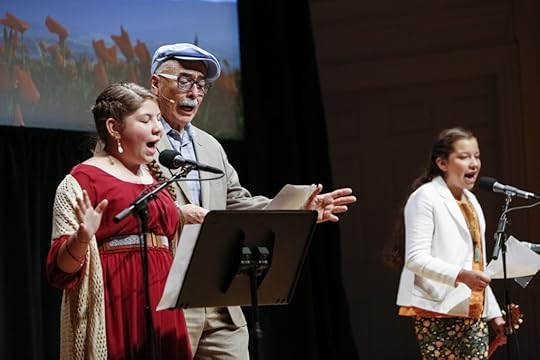
Juan Felipe Herrera with young poets Sarita Sol Gonzalez (left) and Elena Medina. Photo by Shawn Miller.
Juan Felipe Herrera, U.S. poet laureate consultant in poetry, has been appointed a second term – an appointment announced, then celebrated in the Coolidge Auditorium on Wednesday night.
“What a great joy, what a great joy this is,” Herrera, the 21st laureate, told the audience. “How beautiful it is to be here. How beautiful the Library of Congress is. How fabulous are the materials – the archives, the manuscripts, the paintings, the prints.”
During his first term, Herrera launched the “La Casa de Colores” project, which invited the public to contribute verses to a poem about the American experience. For his second term, he will develop a new project to be announced later this summer.
At Wednesday’s event, which also served to close out Herrera’s first term as poet laureate, he had two up-and-coming “poet laureate chicas” – 11-year-old Sarita Sol Gonzalez and 12-year-old Elena Medina – join him on stage to read not only their poems but a poem the three had composed together.
Mark Harsell, editor of the Library of Congress staff newsletter, The Gazette, contributed to this report.
April 14, 2016
Jacob Riis Exhibition Opens Today
(The following story, written by Mark Hartsell, is featured in the Library of Congress staff newsletter, The Gazette.)
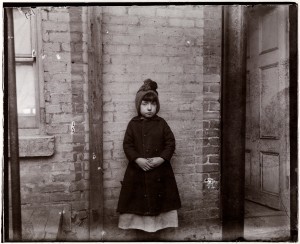
Katie, photographed by Jacob Riis at the West 52nd Street Industrial School. Museum of the City of New York. Gift of Roger William Riis.
Half the world, journalist Jacob Riis once said, doesn’t know how the other half lives, and it doesn’t know because it doesn’t care.
Riis, a social reformer, author and newspaper reporter, used his work to make society take notice, exposing the squalid living and working conditions in late 19th-century New York during the height of European immigration to the city.
“My first assignment as a Reporter – Stayed 25 years – not willingly – after one year wanted to get out – was made to stay,” Riis once wrote about his work in notes for a lecture. “Compelled there to see the seamy side of everything. I looked behind the gore and the grime of it for the cause.”
A new Library of Congress exhibition explores Riis’ life, work and legacy. “Jacob Riis: Revealing ‘How the Other Half Lives’” opens today in the Jefferson Building’s South Gallery and runs through Sept. 5.
The exhibition – a co-presentation of collection items from the Library of Congress and the Museum of the City of New York – showcases correspondence, photographs, maps, drafts and published works, lecture notes, a lantern-slide projector and period camera equipment.
A version of the exhibition concluded at the New York museum on March 20. Other versions will be presented in Denmark later in 2016 and 2017, in Copenhagen and Riis’ hometown of Ribe.
“We settled on a co-presentation approach – creating unique versions of the exhibition for our different audiences that together paint a fuller picture of Riis and his work,” said Cheryl Regan, senior exhibition director in the Library’s Interpretive Programs Office. “The Library’s exhibition brings to the forefront Riis’ passion for social reform, which will resonate with our visitors because the issues Riis sought to address are still very much with us.”
View from the Street
Riis immigrated to the United States in 1870 and, at age 21, embarked on what at first was a difficult life in a new country. He lived an essentially homeless existence for a time in New York City – frequently hungry, sleeping in the street, considering suicide.
Riis eventually found work as a police reporter for the New York Tribune and, later, the New York Evening Sun, work that gave him an intimate view of how New York’s poor lived – a view he shared with his readers.
“He was privy to the inside of people’s apartments, and the people that were in the street in the middle of the night and the alleyways and the newsboys who worked and slept in the street at night,” said curator Barbara Bair of the Manuscript Division. “He got to know all these people. He used their stories in his journalism and books.”
While a reporter, Riis utilized a new German innovation, magnesium powder flash, to photograph residents of the Lower East Side. He used the images in his lantern-slide lectures and published line-drawing and half-tone versions in his articles as vivid proof of the truth of his words.
Shocking into Action

Bandits’ Roost, an alley at crime-ridden Mulberry Street in New York. Jacob Riis, Richard Hoe Lawrence, and Henry G. Piffard, photographers. Bandits’ Roost, 1887–1888. Museum of the City of New York. Gift of Roger William Riis.
Riis once accompanied health inspectors on a raid of a lodging house and photographed a room that measured not even 13 feet long or wide, he said, but still slept 12 men and women, some in bunks, the rest on the floor.
With such images, Riis hoped to show the wealthier classes just how the other half lived and appeal to their Christian charity to support measures to modernize tenements with better sanitation, ventilation and lighting and with parks for children.
“Part of his purpose was to shock people into action. Some of the photographs had a startling or revealing detective-style quality; others invited personal empathy,” Bair said. “He had the idea that you can use visual evidence to persuade people.”
After he left the Sun in 1899, Riis wrote magazine articles, delivered lectures nationwide illustrated by his photographs, and authored several books, including the best-sellers “How the Other Half Lives” and an autobiography, “The Making of An American.” His work made him a celebrity.
Friend in High Places
Riis’ work in the 1890s made a strong impression on New York City’s new police commissioner, Theodore Roosevelt.
Roosevelt called Riis the “most useful citizen in New York” and helped push through reforms to clean up the police department and improve conditions for the poor.
“No one ever helped as he did,” Riis wrote of the future president. “For two years, we were brothers in Mulberry Street.”
He and Riis remained close friends when Roosevelt became president in 1901.
Riis died in 1914, leaving a legacy of dogged reform on issues of housing, homelessness, public space, immigration, crime, education, public health and labor.
“I was a writer and a newspaper man, and I only yelled about the conditions which I saw,” Riis said, three years before he died. “My share in the work of the slums has been that. I have not had a ten-thousandth part in the fight, but I have been in it.”
“Jacob Riis: Revealing ‘How the Other Half Lives’ ” and its programming at the Library are made possible through the support of the Library of Congress Third Century Fund; Queen Margrethe and Prince Henrik’s Foundation; the Ministry of Foreign Affairs of Denmark, Danish Ministry of Culture, and the Danish Agency for Culture and Palaces; the Royal Danish Embassy; and the Robert Mapplethorpe Foundation.
April 12, 2016
Technology at the Library: StoryCorps Goes Global
(The following is an article by Nicole Saylor of the American Folklife Center for the March/April 2016 issue of the Library of Congress Magazine, LCM. You can read the issue in its entirety here.)
The StoryCorps oral history collection is growing through a new mobile app and website.
 In a matter of months last fall, the StoryCorps collection of oral histories more than doubled. The majority of new interviews were conducted during the project’s first annual “Great Thanksgiving Listen,” which encouraged students to record interviews with their families. But the project also got a boost in participation following the recent launch of a new mobile app and website.
In a matter of months last fall, the StoryCorps collection of oral histories more than doubled. The majority of new interviews were conducted during the project’s first annual “Great Thanksgiving Listen,” which encouraged students to record interviews with their families. But the project also got a boost in participation following the recent launch of a new mobile app and website.
Housed at the American Folklife Center at the Library of Congress, Storycorps is one of the largest oral history projects in existence, with more than 50,000 recorded interviews. Selected interviews have been featured regularly on NPR’s “Morning Edition.”
StoryCorps was launched in 2003 by documentary producer Dave Isay in collaboration with the Library of Congress to capture the stories of ordinary people throughout the nation. Interviews have been collected in mobile recording booths across the country, as well as in permanent StoryBooths located in New York, Chicago, San Francisco and Atlanta. The mobile booth will return to the Library of Congress in Washington, D.C., from April 15 through May 18, 2016.
In 2015, Isay was awarded the TED (Technology, Entertainment, Design) Prize, given annually to an exceptional individual with “One Wish to Change the World.” The prize comes with $1 million to invest in a powerful idea. Isay’s vision was to create an app, with a companion website at StoryCorps.me, which guides users through the StoryCorps interview experience from recording to sharing the story online. The website serves as a home for these recordings and provides interviewing tips and editing tools.
Technology has made it possible for anyone to participate via the app or through the StoryCorps.me site. The ability to conduct and share interviews independent of a StoryCorps recording booth provides a global platform whereby anyone in the world can record and upload an oral history.
Using the microphone and speaker in most contemporary mobile devices, the new app “can give you instructions. It can send audio files. Those are the key ingredients,” says Isay. “It helps you pick questions, and gives you all the tips you need to record a meaningful StoryCorps interview, and then with one tap upload it.”
The Library of Congress is able to meet the challenge of acquiring tens of thousands of interviews at a time thanks to the ability to harvest them via the web. This process involves using StoryCorps’ application programming interface (API) to download the data—something Library and StoryCorps technologists spent months engineering. The Library will regularly gather copies of these uploaded interviews from the StoryCorps.me site for long-term preservation.
While traditional StoryCorps interviews can be accessed onsite at the Library of Congress, access to the do-it-yourself recordings will be through the StoryCorps.me website.
“We are excited to see our decade-long collecting partnership with StoryCorps go global,” said American Folklife Center Director Elizabeth Peterson. “This effort is an exciting next step in the project, which is a living record that is truly of, by and for the people.”
April 8, 2016
Pic of the Week: Alice’s Adventures in the Library
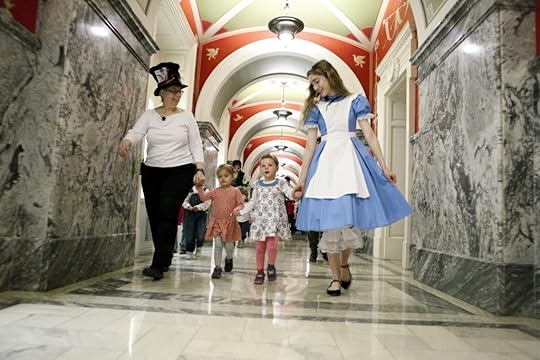
The Mad Hatter and Alice lead children on a parade through the Library following a storytime reading of “Alice’s Adventures In Wonderland.” Photo by Shawn Miller.
In commemoration of the 150th anniversary of Lewis Carroll’s classic “Alice’s Adventures in Wonderland,” the Young Readers Center in the Library of Congress hosted Alice herself, who read from her adventures and led a parade through the halls of the Library’s Thomas Jefferson Building.
The Library of Congress has multiple illustrated editions of Carroll’s noted work, including this digitized copy and an 1866 edition that was also the first regularly published edition.
April 7, 2016
Library in the News: March 2016 Edition
Headlining Library of Congress news for March was the announcement of new selections to the National Recording Registry.
Michael O’Sullivan of The Washington Post spoke with singer Gloria Gaynor, whose “I Will Survive” was one of the selections.
“For Gaynor, the Library of Congress honor simply acknowledges what the world has already figured out,” he wrote. “‘The honor means that it will be purposefully preserved,’ she says,” “‘whereas the song itself has kind of been accidentally preserved, and passed down, without any real purpose, from generation to generation. It’s like a family heirloom, and now it’s like a family heirloom of the family of the United States.’”
“It’s a trip through the 20th century, with something for everyone, including plenty of romance, from a 1911 recording by the Columbia Quartet of ‘Let Me Call You Sweetheart’ to Julie London’s version of ‘Cry Me a River’ in 1955,” reported Jeffrey Brown for PBS NewsHour.
“There’s nothing more American than Bobby Darin’s swingin’ version of ‘Mack The Knife’—a song so embedded in U.S. culture that it was just inducted into the Library of Congress National Recording Registry,” wrote Erin Blakemore for Smithsonian. “Or is there? It turns out that the toe-tapping, bizarre tune is a product of Germany…and its history is as convoluted as the tale of Old Mack himself.”
Kelly Carlin, daughter of comedian George Carlin, responded to the Library of Congress Facebook page with “On behalf of my father, George, I can unequivocally say that he would be thrilled, over the moon, with this honor. Thank you, Library of Congress for recognizing his essential place in the cultural history of this nation. (We’re all a bit verklempt over here at the Carlin house).” George Carlin’s “Class Clown” album earned his spot on the list.
Metal band Metallica also reported on the addition of their third album “Master of Puppets” being added to the list. []
Also covering the story were national outlets including NPR, CBS Evening News and Sunday Morning, Associated Press, Time Magazine, Rolling Stone, Variety and Conan, among many others.
Speaking of recording registry, The Atlantic highlighted the inclusion of the fourth-quarter radio coverage of Wilt Chamberlin’s 100-point game (Philadelphia Warriors vs. New York Knicks) March 2, 1962, emphasizing the importance of radio preservation.
“Today, those 36 seconds were entered into the National Recording Registry at the Library of Congress,” wrote Adrienne Lafrance. “Most radio isn’t so lucky.
“In what the Library of Congress is billing the largest digital humanities and history initiative in the discipline of film and media, the Radio Preservation Project seeks to identify, catalogue, and preserve a gargantuan—and, for now, disparate—collection of noncommercial radio recordings in the United States.”
In other audio recording news, Library experts continue to be featured in The Washington Post’s series of “Presidential” podcasts.
While the selections included in the registry are considered culturally significant to American heritage, the Library also recognizes culturally significant contributions made by individuals. In March, the institution announced that Mario Vargas Llosa is the recipient of a Living Legend Award.
Also making the announcement were Fox News Latino, Latin Times and .
Speaking of awards, the Library also announced that author Marilynne Robinson will receive the Library of Congress Prize for American Fiction.
According to Ron Charles of The Washington Post, “Robinson said she was ‘awfully happy to be on the list’ of winners because she feels such a strong kinship with the classic authors of the United States.”
Also running the news was the Iowa City Press-Citizen, Associated Press and The Examiner.
And, for a bit of holiday fun, CBS Sunday Morning spoke with the Library’s Stephen Winick of the American Folklife Center on the origins of the Easter Bunny.
April 6, 2016
Rare Book of the Month: A Billedbog to a Boy
(The following is a guest blog post written by Elizabeth Gettins, Library of Congress digital library specialist.)
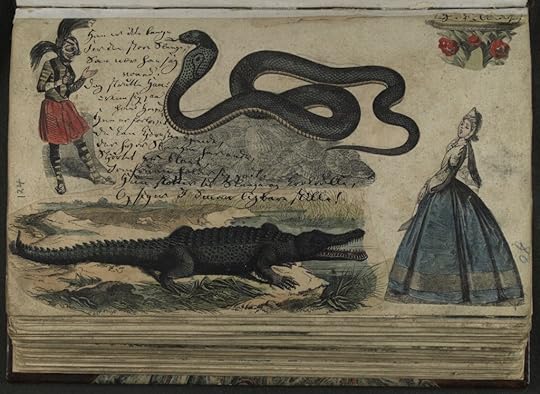
Sample page of “Billedbog til Jonas Drewsen,” by Hans Christian Andersen,
with Andersen’s handwriting describing the events depicted. Rare Book and Special Collections Division.
“Billedbog” is a Danish word for picture book, and one lucky boy by the name of Jonas Drewsen was gifted this picture scrapbook by the very famous children’s author Hans Christian Andersen. This one-of-a-kind book is not the product of any printing press but was instead handcrafted in Kjøbenhavn, Denmark, in 1862 by Andersen and his Councilor of State friend Adolph L. Drewsen. Andersen and Drewsen both applied their handiwork by pasting fanciful pictures in this album and writing stories, poems and rhymes about the pictures in and around the margins. The book was then presented to Drewsen’s grandson, Jonas, who was around eight years old at the time.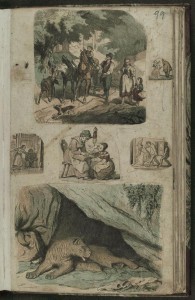
The pictures are hand-colored and are taken from American, English and German papers and from books and periodicals – all pasted in a collage form. Andersen himself contributed poems and rhymes for 19 of the pictures. They can be viewed in the margins or around the illustrations.

Hans Christian Andersen. Prints and Photographs Division.
In total, this 140-page book features hundreds of illustrations that appeal to a young boy’s imagination. Many of the scenes include soldiers from various time periods, the cavalry, sword fights, boxing matches, tropical forests, various modes of transportation and many different scenes of children at play. Animals also play a large part of this scrapbook, including various depictions of snakes, lions, gorillas, pigs, cows, horses, bears, insects, fishes and birds of prey among others. Leafing through the pages offers nearly endless possibilities for conjuring up story after story to please the fancy of a young boy.
This scrapbook is part of a the Jean Hersholt Collection, which is comprised of Andersen’s early writing and papers, as well as first editions of the writings of his personal friends including Hugh Walpole and Sinclair Lewis. Hersholt was a Danish-born actor who moved to the United States and became a leading film and radio talent.
In the early 1950s, Hersholt and his wife presented their collection of Anderseniana to the Library of Congress. It is likely the most comprehensive collection in America of first editions, manuscripts, letters, presentation copies and pictorial material relating to Hans Christian Andersen. Formed by the collectors over a 30-year period, it chronicles Andersen’s publications beginning with his first book, “Ungdoms-Forsøg” (“Youthful Attempts”), published in Copenhagen in 1822 under the pseudonym William Christian Walter. Among the first editions in the collection are the six pamphlets published by C. A. Reitsel of Copenhagen between 1835 and 1842 titled, “Eventyr, Fortalte for Børn” (“Fairy Tales Told for Children”). These contain the earliest printings of 19 of Andersen’s fairy tales, among them “The Emperor’s New Clothes” and “Thumbelina.” The collection also includes manuscripts of several other fairy tales, Andersen’s correspondence (1868-74) with his American publisher Horace E. Scudder, volumes inscribed by Andersen, early translations, significant posthumous editions and works about Andersen.
“Billedbog til Jonas Drewsen” joins many other rare children’s books available on the Library’s website.
April 4, 2016
New Online: Civil War and Persian Gulf Stories, National Recording Registry
(The following is a guest post by William Kellum, manager in the Library’s Web Services Division.)
The Manuscript Division has added two collections to its growing list of Civil War materials now available online.
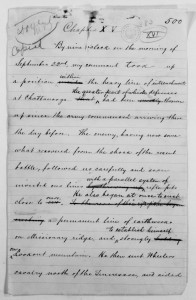
Sheridan’s Papers include a draft of his published memoirs. Manuscript Division.
The papers of army officer Philip Henry Sheridan (1831-1888) span the years 1853-1896, although the majority of the material dates from 1862 to 1887. Relating chiefly to the Civil War, Reconstruction, Mexican border disputes, Indian wars and military administration, the collection of approximately 18,000 items includes correspondence, reports, orders, memorabilia, scrapbooks, commissions, financial records and speeches. Dominated by correspondence and reports, the papers document Sheridan’s service as a Union army commander in the Civil War and his postwar commands up to and including that of commanding general of the United States Army (1883-1888). A draft of Sheridan’s published memoirs is included in the collection. Two letters from Abraham Lincoln to Sheridan, written on September 20 and October 22, 1864, can be found in the General Correspondence series, and letters received from Generals William T. Sherman and Ulysses S. Grant are located in the Autograph Letters section of the Sheridan Papers.
The Nathan W. Daniels Diary and Scrapbook also documents the experience of an officer in the Union army during the Civil War, but in this case a colonel of the 2nd Regiment of the Louisiana Native Guard, an African-American infantry regiment chiefly stationed at Ship Island, Mississippi. The collection, spanning the years 1861-1867, consists of three volumes of a handwritten diary with rare photographs, illustrations and newspaper clippings mounted throughout the text. Also included are a typescript of summaries and transcripts of the bulk of the diaries, and a scrapbook of newspaper clippings.
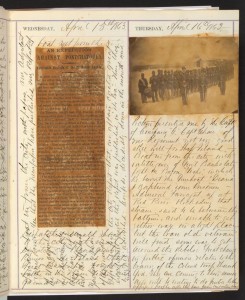
A page from Nathan Daniel’s Diary. Manuscript Division.
Volume three was written jointly by Daniels and his wife, the noted spiritualist medium Cora Hatch. Nathan Daniels notes throughout the three volumes of the diary his own interactions with spiritualists and attendance at spiritualist events. After his marriage to Cora Hatch in December 1865, some diary entries not only include content about Daniels’s activities within the spiritualist community but occasionally also document the content of interviews with spirit guides speaking through Cora Daniels.
Also new this month is the annual update to the National Recording Registry. You can read the full description of all 25 new inductees, which span the years 1911-1986. Among the selections are the rock group Santana’s 1970 album “Abraxas,” two blues numbers from the 1920s (Clarence Williams’ 1923 “Wild Cat Blues” and Blind Willie McTell’s 1928 “Statesboro Blues”), Julie London’s 1955 recording of “Cry Me A River,” George Marshall’s 1947 speech outlining the Marshall Plan to restore Europe following World War II, saxophonist John Coltrane’s 1964 oeuvre “A Love Supreme,” Merle Haggard’s 1968 song “Mama Tried,” Clifton Chenier’s 1976 Zydeco album “Bogalusa Boogie,” Buffy Sainte-Marie’s 1964 album “It’s My Way,” George Carlin’s groundbreaking 1972 comedy album “Class Clown” and Metallica’s 1986 takeoff from its thrash-metal roots, “Master of Puppets.” Listen to an audio montage of the selections:
{mediaObjectId:'2E05058667BC00F2E0538C93F11600F2',playerSize:'mediumStandard'}
The Veterans History Project has a new presentation in its series of featured interviews: Experiencing War: The Persian Gulf War, 25 Years Later. In these audio and video interviews (some also including photos and written materials), veterans describe in their own words their experiences serving in the conflict, relating how they coped with challenges such as Scud missile alarms, potential chemical weapon attacks and the harsh desert environment. The voices of female veterans are of particular note: the Persian Gulf War saw the largest deployment of women to a combat theater in American history.
April 1, 2016
Pic of the Week: Ask Us Anything on Rosa Parks
Stephen Wesson, an educational resources specialist, answers online questions during a Reddit “Ask Me Anything” session on the Library’s Rosa Parks Collection. Photo by Shawn Miller.
Library experts involved in making the papers of Rosa Parks available online answered questions in a Reddit “Ask Me Anything” (AMA) session on Tuesday.
During the Reddit AMA, experts from the Library of Congress Manuscripts Division, the Prints and Photographs Division and Educational Outreach took questions about Rosa Parks and about how the Library cataloged, preserved, digitized, and made her papers available to the world.
Here are some of the highlights:
QUESTION: As a non-American whose familiarity covers only the basics of the civil rights movement, what new historical insights and knowledge do you think will we be able to gain from her papers about topics such as the insight workings of the civil rights movement?
ANSWER: This might not be an expected answer to your question, but it is what immediately came to my mind when I read it (and I thank you for that, because I haven’t had a chance to write about this). The collection makes the personal sacrifices of civil rights activists palpable. One of the most poignant aspects of the collection is the way it documents the sacrifices Rosa Parks made in standing up to discrimination. Most of us I think know that she and her husband lost their jobs in the weeks following her arrest. Neither of them was able to find sustained employment in Montgomery after that. But did we know the extent and duration of the poverty that resulted from their prolonged unemployment? The collection includes their income tax returns. In 1955, they had a combined income of $3,749.94. Their combined income tax return for 1959 lists only $661.06. By then they were living in Detroit, a city that had been rocked by the 1957 recession. Rosa Parks was also grappling with serious medical conditions.
In 1960, a reporter for Jet magazine spent the day with Mrs. Parks. In a feature article, magazine’s readers learned that the woman whose courage had launched the Montgomery Bus Boycott was “penniless, debt-ridden, ailing with stomach ulcers and a throat tumor, compressed into two rooms with her husband and mother.” Few people knew the conditions under which this proud woman was living. In 1965, newly-elected Congressman John Conyers hired Mrs. Parks to work in his Detroit office, providing her with greater financial stability.
There was backlash against the Montgomery Improvement Association (MIA) for not giving financial assistance to Rosa Parks and her husband when they were in such need. In 1957 the Pittsburgh Courier wrote about her poverty, implying that something should have been done within the movement to help the family. On November 21, 1957, Rosa Parks wrote to her husband that she was sick over the articles and would not have said anything against the MIA. Civil rights leaders in Montgomery had written a strong reply to the newspaper.
QUESTION: What’s the most surprising discovery in the collection?
ANSWER: Thanks for your question. I think each of us will have a different answer. For me, I was struck by Rosa Parks as a writer. Her writing is powerful, clear-eyed, revealing, and lyrical. If you have only a limited time to look at the collection, I suggest that you look at three folders of her early writings. They are largely undated and fragmentary, but very powerful. Folder 1 and Folder 2 concern racial discrimination in general and her bus protest and the boycott in particular. The third folder contains autobiographical writings.
But if you don’t have time to look at all three, read this one page about “treading the tight rope of Jim Crow” that moved me so greatly. In it, she weaves together the imagery to ropes, strings, and lines:
“Treading the tight-rope of Jim Crow from birth to death, from almost our first knowledge of life to our last conscious thought, from cradle to the grave, is a major mental acrobatic feat. It takes a noble soul to plumb this line. There is always a line of some kind – color line, hanging rope, tight rope.”
“To me it seems that we are puppets on strings in the white man’s hands. They say we must be segregated from them by the color line, yet they pull the strings and we perform to their satisfaction or suffer the consequences if we get out of line.”
SECOND ANSWER: The item that surprised me the most was one of the first items I saw. It’s one I go back to again and again: “I had been pushed around….”
Having grown up with the Rosa Parks myth, I saw – right before my eyes – the incontrovertible evidence that Parks wasn’t just “tired” that day. Even though I already knew this history, seeing her handwritten words made a powerful impact on me. The pages following this one are equally moving.
We have heard from teachers who have incorporated this page in their classroom activities; an interesting note is that students often insist on reading Rosa Parks’ handwritten notes, even when a transcript is available. To me, this shows that students instinctively recognize the power of the original.
QUESTION: How did Parks interact with the Civil rights movement and it’s leaders after the boycott, say up until 1970? Did she correspond with people like John Lewis, and keep up her acquaintence with King?
ANSWER: After the bus boycott Rosa Parks remained active in the civil rights movement. She participated in the Prayer Pilgrimage (1957), the March on Washington (1963), Mississippi Freedom Summer (1964), the Selma to Montgomery March (1965), and the Poor People’s Campaign (1968). She maintained a lifelong friendship with Coretta Scott King and served on the board of trustees of the Martin Luther King Center for Nonviolent Social Change. She fought for women’s rights and against the Vietnam War. She advocated for prisoners and supported the growing Black Power movement. Rosa Parks was employed by Congressman John Conyers (D-Michigan) from 1965 to 1988. She worked with local groups to improve Detroit. She supported Jesse Jackson’s 1964 presidential campaign. In the mid-1980s she participated in anti-apartheid protests. She was part of the welcoming party for Nelson Mandela when he visited the U.S. She co-founded the Rosa and Raymond Parks Institute for Self-Development with Elaine Steele in 1987 to promote and direct youth. She addressed the 1995 Million Man March. In 2000, Rosa Parks met with Pope John Paul II in St. Louis and read an appeal for racial healing. The Rosa Parks collection at the Library of Congress includes manuscripts and photographs that document these associations and varied activities.
SECOND ANSWER: Great question. Many photographs in the collection show how active Parks was within the civil rights community long after the boycott, through the 1990s. Some examples from the 1960s and 1970s show her supporting activist Sallye Davis, mother of Angela Davis. Here she’s with Congresswoman Shirley Chisholm. We also have photos of Parks with Stokely Carmichael. She also attended NAACP related events with Coretta King and maintained a friendship with her after Kings death. Here she is at an event with King, around 1970.
Here is the full transcript of the Library’s Rosa Parks Reddit session.
10 Stories: April Fool! Chronicling America
In celebration of the release of the 10 millionth page of Chronicling America, our free, online searchable database of historical U.S. newspapers, our reference librarians have selected some interesting subjects and articles from the archives. We’ve been sharing them in a series of Throwback Thursday #TBT blog posts — one day late today, due to the special holiday.
Today we return to our historical newspaper archives for stories about that most impish of holidays, April Fools’ Day. Keep a sharp eye out and don’t believe every bit of news you hear…
“April Fools of Today and Yesterday”
An extensive survey of the holiday throughout time and around the four corners of the globe, in the Topeka State Journal, March 30, 1912.
“An Idyll of April 1 — What Fools These Mortals Be!”
Wherein “the small boys’ well-tried and proven schemes will hold sway,” those including “the wallet with a string to it,” “the fastened coin,” the cotton apple dumpling,” “the hurtful tack” (ow), “string for the unwary,” and “the same old brick in the hat joke” (a favorite of ours). Washington (D.C.) Morning Times, March 29, 1896.
“All Fool’s Day—A Relic of Ancient Rome”
The Clarksburg (W.Va.) Sunday Telegram of March 28, 1915, pegs the holiday to classical Roman times. No explanation, however, of how that brick-in-the-hat ties into Caesar’s era.
[image error]
“Life’s April Fool,” illustrated advertisement from the Ogden (Utah) Standard, April 1, 1919.
“Life’s April Fool“
A sumptuous, full-page ad in the Ogden (Utah) Standard, April 1, 1919, uses rich illustrations and the words of Lord Byron to encourage folks to deposit their money in “Odgen’s good banks” and hence, avoid being life’s prize April Fool.
“French Answers to Query ‘Why Is An April Fool?‘”
The Washington (D.C.) Evening Star of April 4, 1909, offers this report on French culture by an American abroad.
“Little Nemo in Slumberland”
Winsor McCay’s classic dreaming little boy visits Indiana while his questionable companions proceed to stick April Fools signs on each other’s backs. Washington (D.C.) Evening Star, April 2, 1911.
“Mr. Tappe’s April Fool Joke and Its Sequel”
A prank gone terribly wrong: “Who Would Have Ever Thought That the Frolicsome Tricks Played on Miss Meer, His Serious Minded ‘Saleslady,’ Would End Up in the Courts!” from the Richmond Times-Dispatch, December 5, 1920.
“Statesmen Recall Their April Fool Pranks of By-Gone Days”
Senators and Congressmen tell of fake wax ladies and exploding cigars, those scamps! Washington (D.C.) Evening Star March 29, 1914.
“In Search of the Origin of April Fools’ Day, the Observer Learns Many Things”
In that same issue of the Washington (D.C.) Evening Star (March 29, 1914)—obviously a slow news day—the writer begins a quest to run down “the cousin of the man-who-rocks-the-boat and the half-brother of the individual who didn’t-know-it-was-loaded,” but ends up learning much more.
“April Fools of Today and Yesterday”
This repeat of the first story in today’s blog is notable that here, in The Daily Missoulian, March 31, 1912, it is alongside an advertisement emphatically endorsing a ballot proposition to open saloons for liquor sales on Sunday afternoons, complete with a portrait of President Abraham Lincoln looking on benevolently to give the venture the needed gravitas—plus a dire prediction of the loss of thousands of dollars in revenue to the Missoula community.
Speaking of Chronicling America, the National Endowment for the Humanities (our partner in the project) has launched a nationwide contest, challenging you to produce creative web-based projects using data pulled from the newspaper archives website. We’re looking for data visualizations, web-based tools or other innovative web-based projects using the open data found on Chronicling America. NEH will award cash prizes, and the contest closes June 15, 2016.
Launched by the Library of Congress and the National Endowment for the Humanities (NEH) in 2007, Chronicling America provides enhanced and permanent access to historically significant newspapers published in the United States between 1836 and 1922. It is part of the National Digital Newspaper Program (NDNP), a joint effort between the two agencies and partners in 40 states and territories. Start exploring the first draft of history today at chroniclingamerica.loc.gov and help us celebrate on Twitter and Facebook by sharing your findings and using the hashtags #ChronAm #10Million.
Library of Congress's Blog
- Library of Congress's profile
- 74 followers



